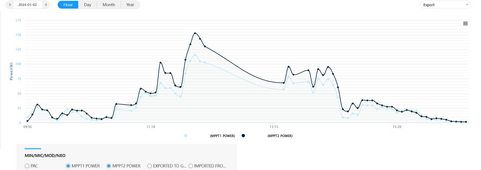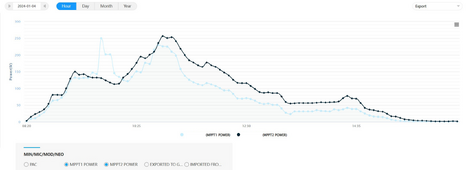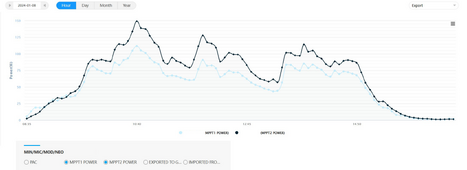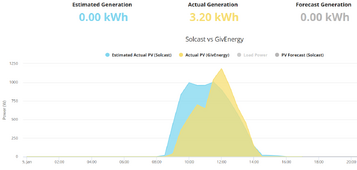I’d appreciate a few expert eyes looking over our solar PV setup. We’re in the midlands and have a system consisting of a 4kW inverter and 16x250W panels, giving 4kW, installed 12 years ago. The inverter was dying, so we had it replaced & moved as part of a house electrical re-wiring. We were quoted for a 3kW Growatt min3000tl-x, but actually had a 2.5kW growatt min2500tl-x installed. I *think* that should be OK for 4kW 12-year old panels and possibly give us more generation overall, or should we push for it to be replaced with the 3kW to be on the safe side? We don't seem to have any documentation on the make/model of the panels and the firm that installed them has since gone bust.
The main question I have is about the two different arrays. We have 3 panels (750W) South-south-west and 13 panels (3250W) East-south-east, both at 35 degree roof pitch. The growatt min2500tl-x has dual MPPTs, so I would have expected the power generated by each to be independent and peak at different times. I.e. as shown by this diagram:

https://www.solarpowerworldonline.com/2014/02/dual-mppt-defined-understanding-mppt/
The East array should generate higher power earlier in the day and the South array should generate higher power later in the day. However, on many days the power generated is identical, which seems very odd. E.g. a few day’s comparison of the power (W) generated by MPPT1 vs MPPT2.




Today was a day without clouds, so it should give a cleaner picture of what’s going on. These are the predicted Solcast curves for each array (note the different power scales):


Here are the voltage, current & power of today's output:

The voltages are reasonably consistent while the currents fluctuate, so I believe that means the array panels are each wired in parallel.

Today's power, full sunshine. Sunrise 08:13, fully aligned with the SSW array 13:35.

There's a definite earlier increase in the power of the 3250W East array today (lightest blue). Around 11ish the panel power levels converge, which is when the sun is exactly half way between them., i.e. 45 degrees off both of them. The South 750W array peaks around 12:30 and they then both decline together, despite the sun being fully on the S array 13:35.
Is there a problem here or is this expected behaviour for separate MPPTs with separate orientations and very different sizes to have very similar power levels during the day?
The main question I have is about the two different arrays. We have 3 panels (750W) South-south-west and 13 panels (3250W) East-south-east, both at 35 degree roof pitch. The growatt min2500tl-x has dual MPPTs, so I would have expected the power generated by each to be independent and peak at different times. I.e. as shown by this diagram:

https://www.solarpowerworldonline.com/2014/02/dual-mppt-defined-understanding-mppt/
The East array should generate higher power earlier in the day and the South array should generate higher power later in the day. However, on many days the power generated is identical, which seems very odd. E.g. a few day’s comparison of the power (W) generated by MPPT1 vs MPPT2.




Today was a day without clouds, so it should give a cleaner picture of what’s going on. These are the predicted Solcast curves for each array (note the different power scales):


Here are the voltage, current & power of today's output:

The voltages are reasonably consistent while the currents fluctuate, so I believe that means the array panels are each wired in parallel.

Today's power, full sunshine. Sunrise 08:13, fully aligned with the SSW array 13:35.

There's a definite earlier increase in the power of the 3250W East array today (lightest blue). Around 11ish the panel power levels converge, which is when the sun is exactly half way between them., i.e. 45 degrees off both of them. The South 750W array peaks around 12:30 and they then both decline together, despite the sun being fully on the S array 13:35.
Is there a problem here or is this expected behaviour for separate MPPTs with separate orientations and very different sizes to have very similar power levels during the day?



